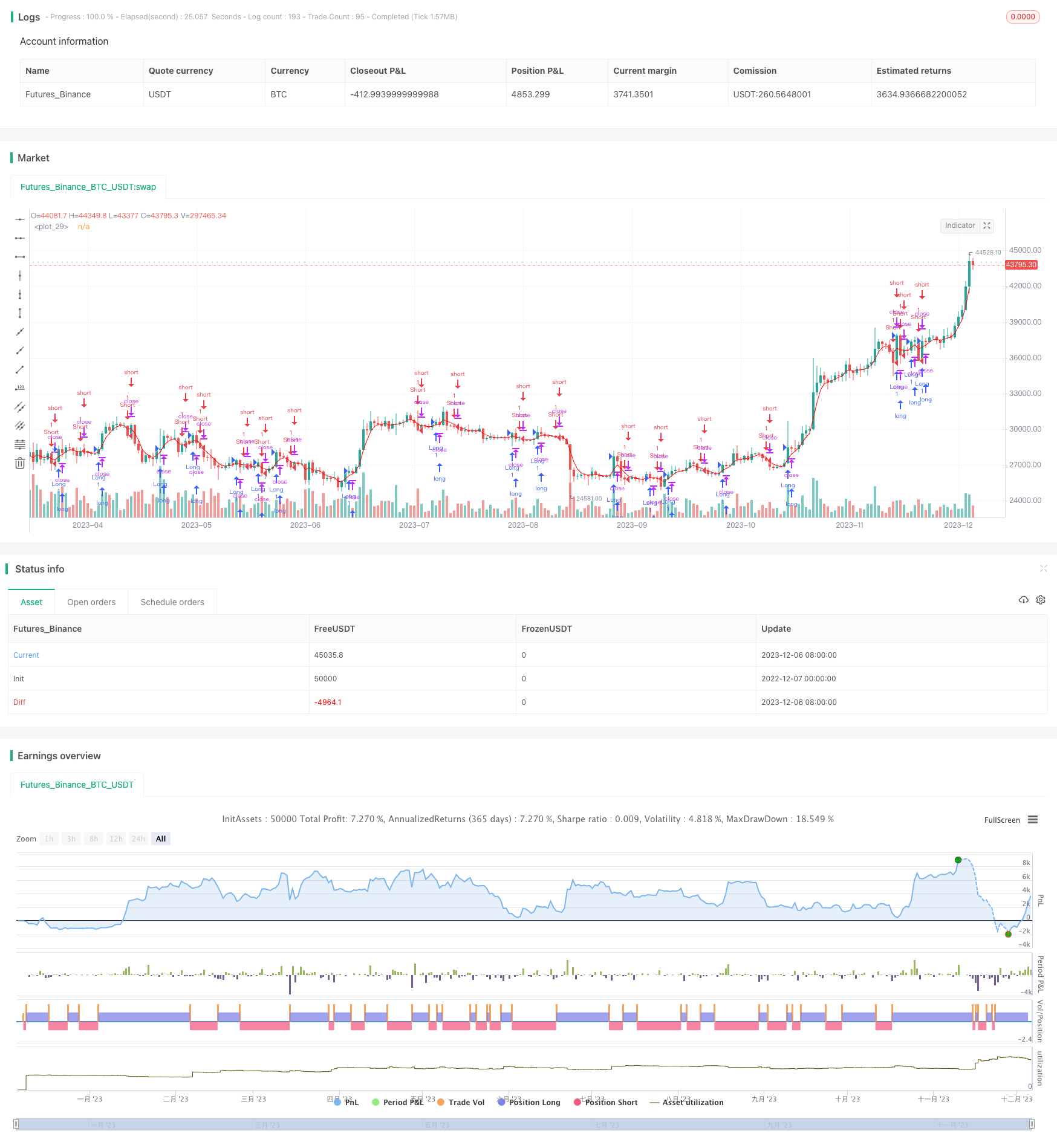
概述
二项式移动平均(Binomial Moving Average,简称BMA)是一种全新型的移动平均线指标。它利用二项式系数的一半来计算平均价,具有计算方式独特、平滑性好、实用性强的优点。
本策略将快速BMA和慢速BMA进行组合,形成类似于MACD的交易信号,属于趋势跟踪策略。它可用于多个周期,适合中长线操作。
策略详情
策略名称
二项式移动平均趋势策略(Binomial Moving Average Trend Strategy)
策略原理
计算二项式移动平均线(BMA)。它根据用户设置的周期长度,计算出二项式系数,然后取其一半值作为权重平均价格。例如周期长度为5,则计算9次二项式系数,取其一半进行加权平均。这使得最近几根K线的权重更大,平滑性更好。
设置快速BMA周期和慢速BMA周期。快速BMA对价格变化更敏感,慢速BMA更稳定。它们的交叉产生交易信号。
当快速BMA上穿慢速BMA时,做多;当快速BMA下穿慢速BMA时,做空。进入场内后,一直持有仓位直至反向信号出现。
优势分析
这套策略最大的优势在于BMA指标的计算方式新颖,它增强了移动平均线的优点,提高了平滑性和实用性。相比EMA和SMA,BMA对最近几根K线的权重更大,同时也保留了更多历史信息。这使它能更好地捕捉趋势,产生更少假信号。
此外,快慢BMA的组合充分发挥了移动平均线的优势,它过滤了大量噪音,只在趋势转折点产生交易信号。策略本身逻辑简单,容易理解和实施,适合中长线操作。
风险分析
该策略主要风险在于:
所有跟踪趋势策略一样,当趋势反转时容易产生亏损。解决方法是设置止损,或优化参数使BMA更灵敏。
BMA参数设置不当也会影响策略效果。如果快速BMA过于灵敏,会增加假信号;如果慢速BMA过于滞后,则可能错过趋势机会。需多组合测试找到最佳参数。
本策略默认全仓交易,可根据风险偏好设置仓位管理,降低单笔损失。
优化方向
该策略的主要优化方向是BMA自身以及组合参数的测试。
周期设置:测试不同的快速BMA周期和慢速BMA周期,找到最优参数组合。一般快速周期在10-30之间,慢速周期在20-60之间。
BMA权重:可以测试不同的权重分配方式,是全部分配二项式系数的一半,还是更偏重最近几根K线。这可能进一步提高BMA的平滑性。
过滤条件:可设置价格突破、交易量增加等过滤条件,避免不合理的信号。
止损机制、仓位管理也可以测试加入,控制风险。
总结
本策略首次提出二项式移动平均这一独特指标,它增强了移动平均线的计算方式,使得策略整体实用性和稳定性都得到提升。快速BMA和慢速BMA的交叉产生简单有效的交易信号。该策略平滑参数和风险控制都有进一步优化的空间,是一套非常有前途的趋势跟踪策略。
/*backtest
start: 2022-12-07 00:00:00
end: 2023-12-07 00:00:00
period: 1d
basePeriod: 1h
exchanges: [{"eid":"Futures_Binance","currency":"BTC_USDT"}]
*/
// This source code is subject to the terms of the Mozilla Public License 2.0 at https://mozilla.org/MPL/2.0/
// © HosseinDaftary
//@version=4
strategy("Binomial Moving Average","BMA", overlay=true, margin_long=100, margin_short=100 ,max_bars_back=96)
//Binomial Moving Average:This type of moving average that is made by myself and i did not see anywhere before uses the half of binomial cofficients for
//averaging the prices for example if the period be 5 then we use the 9 degree binomial cofficients(that yields 10 cofficients) and use half of them.
//we use 126/256 for last bar,84/256,36/256,9/256 and finally use 1/256 for 5th bar. Seemingly this MA works better than EMA.
fa_ma=input(title='Fast MA',defval=10)
sl_ma=input(title='Slow MA',defval=30)
fac(n)=>
fact=1
for i= 1 to n
fact:=fact*i
fact
cof= array.new_float(sl_ma)
hn_ma(price,length)=>
sum=1.0
sum1=0.0
array.set(cof,length-1,1)
for i=2 to length
array.set(cof,length-i,fac(2*length-1)/(fac(i-1)*fac(2*length-i)))
sum:=sum+array.get(cof,length-i)
for i=0 to length-1
array.set(cof,i,array.get(cof,i)/sum)
sum1:=sum1+array.get(cof,i)*price[i]
sum1
hn1=plot(hn_ma(close,sl_ma) , color=#00ff00)
hn2=plot(hn_ma(close,fa_ma) ,color=#ff0000)
fill(hn1,hn2,color=hn_ma(close,fa_ma)>hn_ma(close,sl_ma)?color.green:color.red)
longCondition = crossover(hn_ma(close, fa_ma), hn_ma(close, sl_ma))
if (longCondition)
strategy.entry("Long", strategy.long)
shortCondition = crossunder(hn_ma(close, fa_ma), hn_ma(close, sl_ma))
if (shortCondition)
strategy.entry("Short", strategy.short)